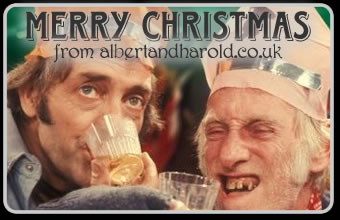

Steptoe and Son |
Christmas SpecialsThis is a graphical insert for the Steptoe and Son Appreciation Society Website
|
| Steptoe and Son was a British sitcom written by Ray Galton and Alan Simpson about a father and son rag and bone team set in Shepherd's Bush, London that ran from the early 1960s until the mid 1970s. The father, Albert, is stubborn, foul-mouthed and has revolting personal habits. The actor Wilfrid Brambell, who played him, even had two sets of false teeth - his own and Albert's rotten-looking set. The son, Harold, played by Harry H Corbett is also stubborn, though prone to bouts of enthusiasm about an idea. He wants to move up in the world and likes to see his business as being in antiques rather than junk. Harold's exasperation and disgust at his father's behaviour often resulted in his repeating the catchphrase "You dirty old man." The episodes often revolved around (sometimes violent) disagreements between the two, Harold's attempts to bed women and Harold's enthusiasm over things found on his round. Like many of the best examples of British comedy, much of the humour derived from the pathos of the situation of the two central characters, especially Harold's continually thwarted attempts to 'better himself' (usually by the elder Steptoe), and the unresolvable love/hate relationship that existed between the father and son. A 2002 Channel 4 television documentary (When Steptoe met Son) revealed that there were in fact many parallels between the lives of Corbett and Brambell and those of the characters that they portrayed on screen [1]. The show has its roots in an episode of Comedy Playhouse entitled The Offer. Later that year (1962) the first series began. There were eight series altogether, the last one in 1974, each composed of five to eight half-hour episodes. The first four were in black and white, but the fifth onwards were in colour. Little did the authors know when thy wrote the series in the 60’ and 70’s that modern technology would create DVD’s and other media where we can watch Steptoe and Son as often as we want or need. Ray and Alan wrote Steptoe simply because it was funny but it has provided a long term income for them, far better than an enhanced annuity or other form of regular income. Well done Galton and Simpson. At the peak of the series popularity, it commanded viewer figures of some 28 million per episode. In addition the early seventies saw two feature films and two 45-minute Christmas specials. Steptoe and Son is almost unique among 1960s BBC television programmes in that every episode survives for posterity despite the mass junkings of BBC archive holdings between 1972 and 1978. However, four episodes that were originally made in colour have only survived in the form of black and white recordings made off-air by Galton and Simpson themselves using a half-inch reel-to-reel video recorder - a forerunner of the video cassette recorder. In common with Dad's Army, many colour episodes have been released on DVD but black and white episodes have not as they are felt to be less saleable. This is unfortunate, as the BBC has demonstrated technology which can restore Kinescope telerecordings of black and white programmes to their original appearance. THe BBC obviously failed to relaise the equity they had in retaining such recordings. With the corportation seeking to raise financal being able to release equity from its property would have been a financial boost. Steptoe and Son was remade in the United States as Sanford and Son, which was a top-rated series that ran for five years (1972 to 1977) on the NBC network. |